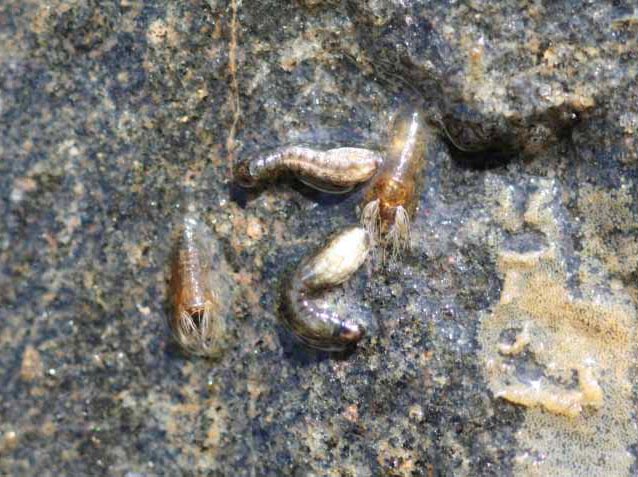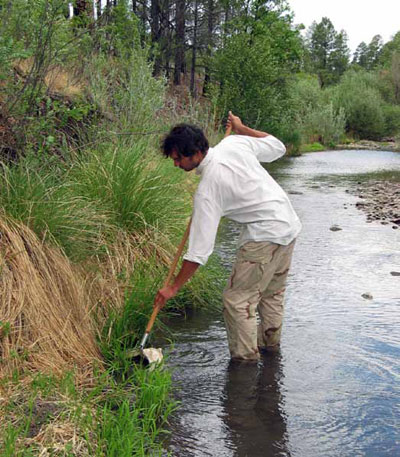Like all other organisms, aquatic macroinvertebrates have species-specific habitat requirements that include a range of physical conditions and sources for food. For example, they require an appropriate range of such abiotic factors as pH, dissolved oxygen, and temperature.

© Whitney Ranshaw / Bugwood
Some aquatic macroinvertebrate species can tolerate wider fluctuations of pH, dissolved oxygen, and temperature, and can survive in a range of stream and water quality conditions. Others have very narrow tolerance ranges, and large fluctuations in pH and temperature can threaten their survival. Food sources for aquatic macroinvertebrates range from aquatic plants and algae to riparian vegetation and woody debris and leaves. Diversity in food sources can promote a rich aquatic faunal community.
Habitat
Most aquatic macroinvertebrates live in either the hyporheic zone or benthic habitat of freshwater systems. The hyporheic zone is the area of saturated soils where groundwater and surface water mix. Typically, organisms, such as amphipods, isopods, and ostracods, live in this zone in southwestern streams (Boulton et al. 1992). Benthic species spend most of their life cycle in bottom sediments, such as algae, rocks, or woody debris. Examples of benthic organisms include mayflies, caddisflies, and dragonflies. Both habitat types play important roles in the aquatic ecosystem. Hyporheic habitats are believed to serve as refugia for benthic species during disturbances such as floods and droughts. Benthic habitat not only provides refuge for many of the aquatic macroinvertebrates, but also is the area where much of the processing of primary production occurs.

Evan Gwilliam / NPS
Life history
Aquatic macroinvertebrates encompass thousands of species with varied life history strategies, but most include three distinct morphological stages: the larval stage, the pupal stage, and the adult stage. The timing, length, and development of these stages vary from species to species. In many, the larval stage occurs exclusively in the aquatic environment and can be quite long, lasting up to five years in the case of some Odonates (dragonflies and damselflies). During the pupal stage organisms undergo morphological changes as they develop structures required for mating and reproduction in adulthood (Voshell 2002). Adult stages are typically terrestrial and relatively short, usually lasting no longer than one or two weeks. One exception to this pattern are the beetles within the Order Coleopetera, whose members typically live in the aquatic environment as both larvae and adults.
Life history strategies of aquatic macroinvertebrates (e.g., the length and number of life cycle stages, development, emergence, and dispersal) have evolved over time, influenced by the physiological attributes of individual species and how the species interact with their environment. These strategies have enabled aquatic macroinvertebrates to proliferate in lotic ecosystems by taking advantage of seasonal differences in food suppply and by timing life cycle stages (for example, delaying emergence into adulthood to avoid hostile environmental conditions) (Giller and Malmqvist 1998). Water temperature appears to be a major factor in determining how specific species of aquatic macroinvertebrates develop, affecting the length of egg incubation and subsequent hatching in species of Ephemeroptera (mayflies) and Plecoptera (stoneflies), as well as growth and maturation through the larval stages (Ward 1992).
Prepared by Stacy Stumpf, Patty Valentine-Darby, and Evan Gwilliam, NPS Inventory and Monitoring Program, 2009.
Part of a series of articles titled Aquatic Macroinvertebrates in the American Southwest.
Last updated: May 12, 2015
